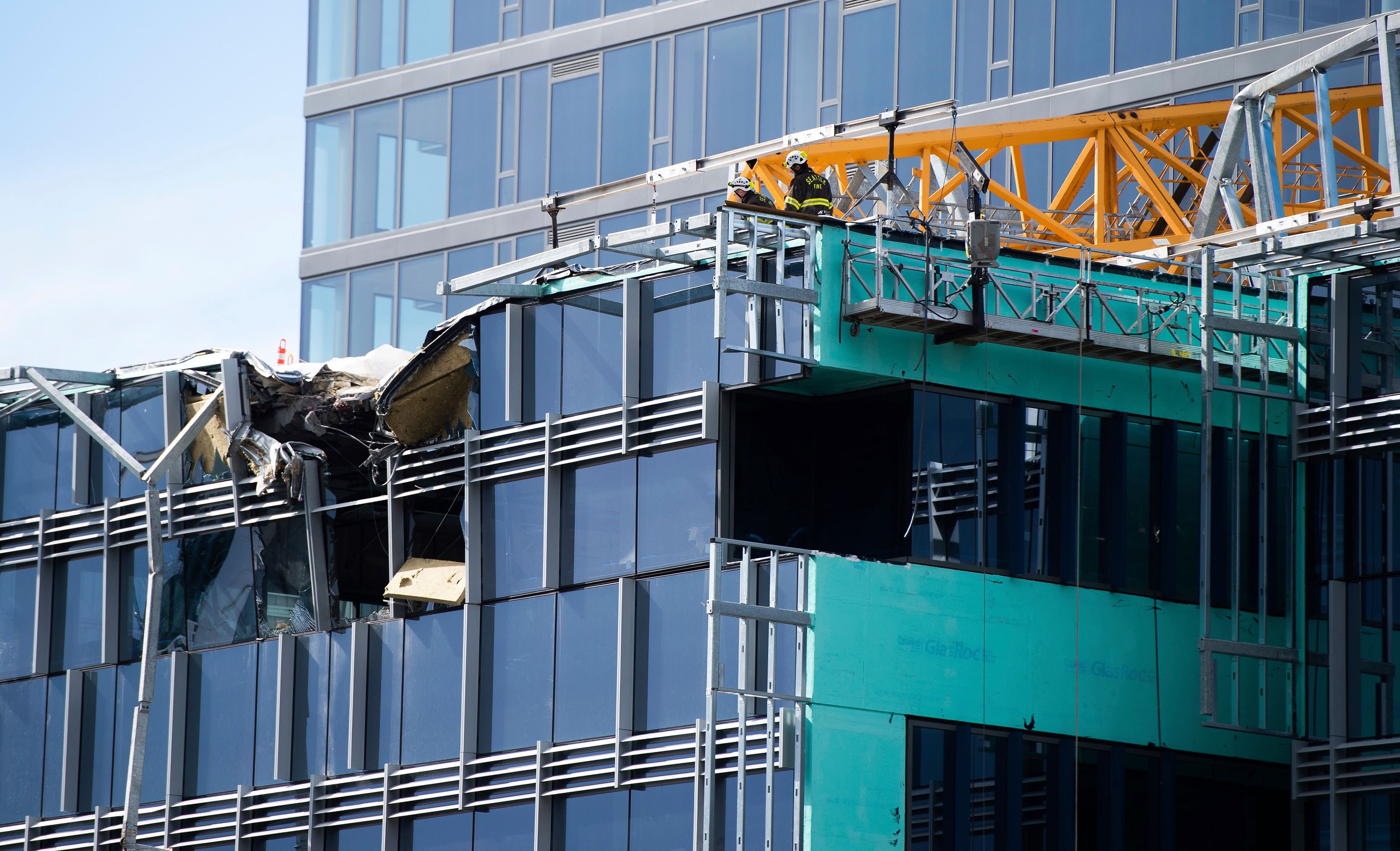Climbing up and down the 20-story tower, crews worked to take apart the crane soaring above the city’s skyline. Each massive, 20-foot piece of the tower was fastened to sections above and below it with eight bolts. Up and down the tower, workers took out six of those eight bolts, and loosened the other two, preparing the crane to be dismantled.
But when the wind picked up, the crane, weakened without the bolts, came crashing down, killing the two workers still on the tower.
That disaster happened in 2012, near Dallas.
The investigation into last month’s crane collapse that killed four people in South Lake Union is ongoing, and the Washington State Department of Labor and Industry (L&I) has been tight-lipped about potential causes. But the possibility that tower bolts or pins were removed early, while the crane was being dismantled in gusty but not exceptional winds, is sure to be a focal point for investigators.
Several crane experts, after closely examining photos and videos of the crash, said they believe pins were removed early. And, they say, it’s a practice that has become common in the industry — a way to save time during disassembly — despite the safety risks they say it brings.
Photos show the tower generally separated in alternating sections: Two sections appear bolted together, followed by a break, followed by two more sections bolted together, followed by a break, etc.
And dashcam video of the falling tower shows the cab and top two sections of the crane flying off, seemingly unattached, when it hits the building below.
“The cab just flies off, it just shoots off like a missile and then the two sections that follow the cab, shoots off like a missile,” said Terry McGettigan, a tower-crane operator, inspector and safety consultant with more than 40 years of experience. “Every two sections are together. That’s because the pins are still in the other two sections.”
The crane experts stressed that they have not been on the scene of the collapse and based their conclusions from photos and video.
The following video shows the fatal April 27, 2019, crane collapse from a dashboard camera and contains explicit language.
“It’s blatantly obvious they removed the pins,” McGettigan said. “The crane would have never tipped over if they wouldn’t have removed the pins. It would have taken hundreds of miles per hour of wind to push that crane over, it’s so stout. It would have never in a million years tipped over if they hadn’t removed the pins.”
“To me, it’s more than obvious it was a shortcut and four people paid their lives because of it,” said Greg Teslia, president of Crane Safety & Inspections, an inspection company based near Miami. “To save a couple hours, that’s the only reason.”
Ironworkers Andrew Yoder, 31, and Travis Corbet, 33, and two passers-by on Mercer Street — Sarah Wong, 19, a Seattle Pacific University student, and Alan Justad, 71, a former City of Seattle employee — were killed in the crane collapse.
L&I is investigating at least five companies potentially involved in the April 27 collapse.
“We do not provide specifics of investigations until they are completed,”said Tim Church, an L&I spokesman.
David Kwass, a plaintiff’s attorney who specializes in crane and construction accidents, stressed that with at least five contractors and subcontractors on the job, it’s impossible for an outside observer to know who may have ordered or directed early pin removal, if indeed they were removed early.
“There are a whole lot of stakeholders here and we don’t know anything about who might have told the ironworkers to do this,” he said. “What I’m looking to understand is, were the pins popped, was that premature, who ordered it, who knew about it, who could have seen it and done something about it?”
One of the things L&I will be looking at is how closely crews followed the manufacturer’s detailed instructions for disassembling the crane, which was made by Liebherr, a German company.
Teslia said he knows of no manufacturer’s instructions that recommend pulling bolts or pins ahead of time.
‘Not the safest way to do things’
A tower crane, the type that dominates Seattle’s skyline, has two main components: a vertical mast that rises hundreds of feet into the air, and a horizontal arm (the jib and the counter-jib) that extends from the mast. The horizontal arm had already been removed from the South Lake Union crane at the time of its collapse.
What was left was a 278-foot tower, composed of a base, 13 separate latticed mast sections and, crowning it all, an operator’s cab.
Each mast section, about 20 feet long and more than 14,000 pounds, has metal sleeves to slot into the one above it. Those connections were then secured by multiple pins at each corner, held in place by torqued nuts.
Typically, Kwass said, a tower crane is dismantled section by section. An assisting crane gets its hook on the uppermost section, then ironworkers unpin or unbolt that section (or sections; often they do two at a time because a tractor trailer can hold two sections) and then the crane lifts it off. The process is then repeated — hook, unpin, lift — until the entire crane is dismantled.
Only when the assisting crane has its hook on a section are that section’s pins pulled.
But Kwass, who is not representing any parties involved with last month’s collapse, also thinks that the South Lake Union crane had its pins pulled, or at least loosened, all the way down the tower, ahead of time, like the one near Dallas.
“That’s what it looks like, it’s pretty likely,” he said. “It happens fairly frequently though everybody understands it really is not the safest way to do things.”
Morrow Equipment owned the tower crane and leased it to GLY Construction, the general contractor for the construction site. Two subcontractors, Northwest Tower Crane Service and Omega Morgan, were hired to disassemble the tower crane and operate the assisting crane that lifted off the pieces of the tower crane. Seaburg Construction employed the operator of the tower crane before workers began to dismantle it.
L&I has said it is investigating all five companies, although that doesn’t indicate any of them were to blame. All five companies either declined to answer questions about the collapse or did not respond to requests for comment.
Kwass likened a tower crane with its pins removed to a stack of children’s blocks. If the blocks are just stacked on top of each other, but not connected to each other, the stack is going to fall over a lot more easily than if the blocks are anchored to each other.
And while a latticed mast might not seem likely to catch wind gusts, crane experts said the sheer square footage of the tower frame adds up.
Teslia said it looked like pins had been pulled not just near the top of the tower, but along most, if not all, of its height.
“If they had just disconnected the top two sections it probably wouldn’t have been an issue,” Teslia said. “The further you go down on the tower, the more overturning force there’s going to be on a tower, and it doesn’t take a whole lot of wind to blow it over.”
‘It saves time, which equals money’
McGettigan reached his breaking point in 2008.
He had reported to his San Diego work site and begun climbing the 460-foot open-air ladder to his catbird seat in the crane’s cab, to begin disassembling the crane.
But as he climbed, he noticed something. The bolts, connecting each 20-foot section of the crane with the next section above it, had been loosened. Many were so loose they could be turned by hand.
He turned around and climbed down.
“I walked off the job and it caused a lot of trouble,” McGettigan said. “I reached my limit, I couldn’t take it anymore, the recklessness. These homemade methods have accumulated over the years.”
Four years after he walked off the job, McGettigan went public with his concerns about what he says has become a fairly standard practice in the crane industry.
Two weeks after the Dallas collapse, he told Engineering News-Record, an industry publication, that pictures showed bolts had been removed prematurely and that led to the crane collapse.
The federal Occupational Safety and Health Administration (OSHA) months later confirmed McGettigan’s hypothesis and fined the crane operator.
“The employers’ procedures for disassembling the mast,” OSHA wrote, “by removing up to six of the eight connecting elements (mast bolts) from every other tower section did not prevent unintended dangerous movement and collapse of the mast.”
The widow of one of the workers killed near Dallas sued the contractors, alleging that they were grossly negligent and disregarded the crane manufacturer’s instructions, OSHA regulations and standard safety procedures. The lawsuit was settled out of court for undisclosed terms. But a tower crane technician for the company testified that it was their “usual practice” to remove bolts in advance, according to court documents. And the crane dismantling supervisor testified that he thought it was “standard industry practice” to untorque bolts.
After the collapse, the supervisor “acknowledged that if he were dismantling the crane now, he would not have taken out the bolts in the same manner,” court papers say.
McGettigan created a website, towercranesupport.com, where he catalogs tower crane accidents and deaths. He points to another similar crane collapse, in Worthing, England, in 2005.
The UK’s Health and Safety Executive, a government agency, ultimately found that collapse, which killed two workers, was “due to mast section bolts being untightened and left ‘finger tight’ in preparation for dismantling the crane.”
McGettigan said the practice of jumping ahead with bolt or pin removal has morphed over the years. Sometimes pins are just de-torqued ahead of time, sometimes they’re loosened all the way to “finger tight,” sometimes a few pins are removed ahead of time, sometimes most of the pins are removed ahead of time.
“People have been doing this for years, all over the world,” he said. “It saves time, which equals money.”
Seattle Times staff reporter Daniel Gilbert and news researcher Miyoko Wolf contributed to this report.


The opinions expressed in reader comments are those of the author only and do not reflect the opinions of The Seattle Times.